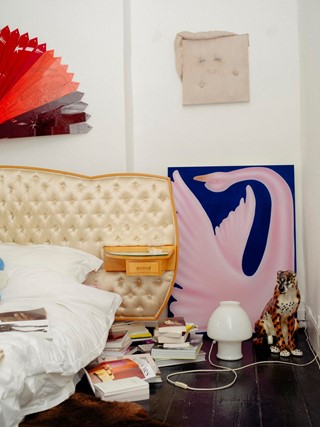Soft Opening is one of few London gallery spaces that never closes. Based in the liminal subterranean belly of Piccadilly Circus tube station, its glass vitrine offers a glimpse at the often insular art world’s most exciting up-and-coming talents, to any and all who happen to pass by – which, in one of city’s busiest thoroughfares, is no small audience.
The person placing them there is curator and gallerist Antonia Marsh, who opened the space last year after despairing over the astronomical cost of renting a traditional gallery in London. In the months since, she has used this treasure chest of a space to show work by Ryan McGinley, Ariana Papademetropoulos and Dozie Kanu, among many others; the exhibitions change almost every three weeks, meaning there’s little to no chance for either the commuters, the station’s staff, or visitors seeking out the gallery to get bored.
In her Hackney home, though, the exhibition continues: a dearth of space and the onset of renovation works drives Marsh to move the works around her own walls almost as often as she does the gallery ones. Here, frames lean against the walls and take up temporary residence in unfinished rooms, telling their own story about Marsh’s trajectory thus far. Here, she walks us through those pieces.
Above: Jonathan Small, Liz Lee, George Rouy
“This [top left] is a fan from an artist I’ve just started working with called Jonathan Small, who graduated from Slade this year. It’s got cowboys, horseshoes and various different imagery laser-cut into it, so there’s quite intense detail on it. That padded painting above the swan is by an artist called Liz Lee; she’s still a student, she’s at CalArts but was in Paris at the Beaux-Arts for a year. She makes her canvases, does make-up tutorials on YouTube, thinks of something sad and then cries, pressing her made-up face into the painting.
“The swan is artist George Rouy, who shows with Hannah Barry, and oh my god I’m so lucky I got that painting. He’s focusing on figures more than swans now. Harley Weir bought one of his paintings and told me about his work, so I nicked him. No, I went to see his show at J. Hammond, and I bought the bull painting that’s next door. He was doing these swans and I just got obsessed with them. What’s amazing with George and this other artist we work with, Ariana Papademetropoulos, is that their work almost seems to be airbrushed, but actually it’s all painted with a brush. I think there’s something quite tragic about the swan, smushed in this little box. It’s halfway between agony and ecstasy and I kind of relate to that.”
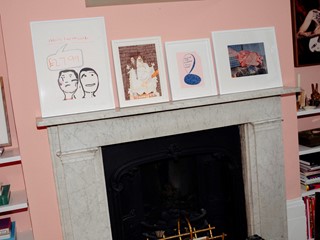
Left: (Left to right) Rose Wylie, Laurence Owen, Hamish Pearch, Harley Weir
“There’s a nice relationship between all of these four. Not just visually – though obviously they’ve all got a bit of pink in, which may or may not have been deliberate, for my pink room.
“This piece on the left is a screen print edition from gallerist Justin Hammond. He is part of a publication called Oof, which is about art and football, and one of the interviews in the first issue is with Rose Wylie. To raise money for the next issue, they produced this edition.
“Hamish [Pearch] curated a show at Justin’s gallery – and that’s one of the first places where I saw Hamish’s work. Hamish made this [second from left] edition here, and we just did a group show with him that he curated at my space in the summer.
“Hamish is really good friends with Laurence Owen who was also at the RA, but years ago Laurence was working with a gallery called 20 Hoxton Square Projects, where I got my first job in the art world. I bought this [third from left] as an uppity intern – he did a massive wall of felt-tip drawings, and I thought it was so cool.
“The print on the right is Harley Weir. She knows Hamish, and they’ve both done shows at Soft Opening. They’re all quite different, though they’re all framed similarly and they all have similar colours.
“In terms of collecting, two of them are editions, and one of them is a drawing and one of them is a print. Those are not normally what you’d understand to be key moments in someone’s collection, but if you’re young and you can’t afford a £60,000 painting, then this is a really good place to start. Everything here was under £2,000, and most of it was much more affordable than that. It’s a really amazing way of buying into or being part of an artist’s development, without necessarily having to get a bigger work. You just keep an eye out for them.”
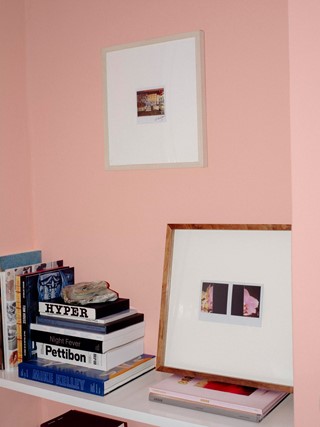

Left: (Left to right) Daido Moriyama, Nobuyoshi Araki
“I had a real photography moment when I was first curating, because at the time it seemed like an easy medium to curate in terms of logistics – printing, framing, shipping. I was doing shows in grotty bars in the East Village in New York because I would show in any space available to me, and so I would work with these photographers – I would get them to send me files and then just print as many as I could, and hang them up everywhere.
“The print above is a Moriyama Polaroid, and the print below is an Araki Polaroid. They’re probably not particularly good things to collect, because Polaroids age so quickly, but I was young and dumb. I bought the Moriyama at Photo London and I bought the Araki from a secret exhibition that he did in Tokyo; the gallery didn’t publicise it or anything, I just found out about it through friends while I was there doing a show. It was so cool to be able to buy that. It is a later work for him – he would splice out the middle, and I guess that’s suggestive.”
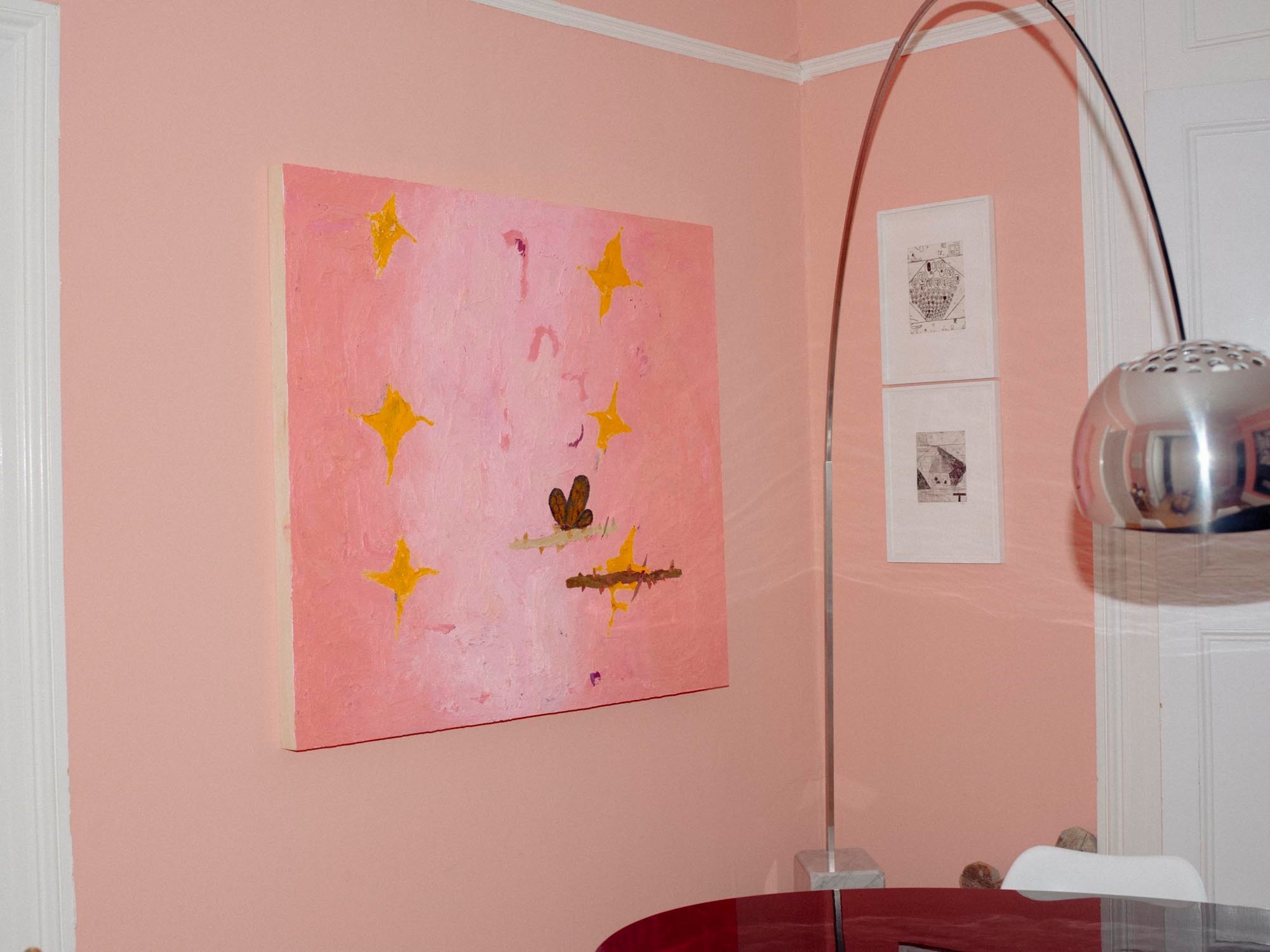
(Left to right) Matt Hilvers, Tal R
“That big pink painting [left] is by Matt Hilvers, he did the first official show at Soft Opening. He’s a painter based in New York and his show was actually mostly a video show, but he’s a really magnificent painter, he really piles on the paint. I saw this painting in his studio in New York, and I knew that I was painting my living room pink – for a while I thought I just wanted pink art in here. It didn’t have the butterfly on the two twigs, and he was saying ‘it’s not finished, the painting just doesn’t feel resolved yet’. He told me that he’d scrawled his new girlfriend’s name in the paint over and over and over again. You can kind of see it. I thought that was so beautiful. I waited and I waited, and eventually he was like ‘ok I think it’s ready’. I love those two little elements to it. It’s such an unusual painting.
“I am a massive fan of Tal R’s work, so I did a pilgrimage on my own for a day and a night to Copenhagen. It was the last weekend of his show at Louisiana, and I was so upset at the idea of missing it, and it’s such a beautiful museum, so I went on the last weekend. I went to the loo next to the gift shop and there were all these amazing editions of his work for sale for really quite reasonable prices, so I just bought two, and carried them home in my luggage. I took them off the wall, basically.”

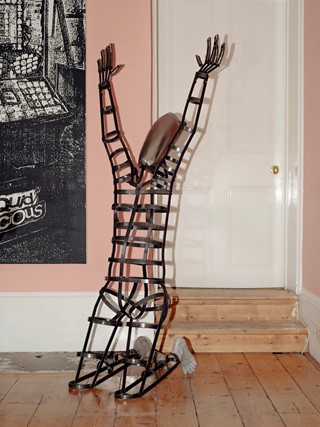
Left: (Left to right) Mike Kelley, Jonathan Small, Gabriella Boyd
“Mike Kelley is one of my absolute diehard favourite artists of all time. He was in a band called Destroy All Monsters. I found this poster [left] on eBay; it’s framed now, but you can see that the corners on the top left and top right have been torn off, and if you go up to it you can see folds in the middle where it’s been folded up. It was a tour poster from when they played a show in Australia, the support act is written up there in Sharpie. It was a really special find because it was like ten quid, and while it’s not worth anything, it’s worth so much at the same time. There’s something really powerful about the torn corners and the folds because it reminds you of the tangibility of time. We look at pictures of artists or artworks from the past, and you forget that this was actually a show that someone played, and loaded-in for, and broke his guitar string at. Though probably not, because I doubt they played acoustic. But anyway.
“Underneath that: another work from Jonathan Small [see: opening image]. He makes these – mostly perspex, but obviously this is metal – fans. These are only half of the diameter; they join in the middle to make a circular floor piece, about 5 metres across. There’s a lot of different referential imagery involved in their design. We took the piece apart and I’m displaying these individual fan sections like this here so they have some kind of life, otherwise it’s so huge. Jonathan’s a really exciting artist, we’re going to NADA with him next month, to do a solo booth.
“This big painting is by Gabriella Boyd. It’s called Assisted Reading, I bought it from her show at BlainSouthern. For her degree show at the Royal Academy, she hung all her paintings on pink felt, so it’s a nice coincidence that here the work is hung on pink walls. I love how she approaches space; spatial depth is totally conflated in her work. It’s bizarre because essentially there’s this extreme focal point right in the centre, but there’s also no focus, at the same time. She’s playing with how we read a painting, fucking with us a little bit. I just love the green and again, it’s a painting that is so open to interpretation, you can get lost in it. I like artworks that you can look at over and over and over again, and see something completely different every time. That’s what draws me to artworks I want to have in the house, things you have that experience with. I need to be able to daydream into the paintings, and the fantasy that Gabriella paints sort of becomes my own.”
Right: (Left to right) Kingsley Ifill, Kira Freije
“The sculpture is by my current favourite, Kira Freije, I was actually in Kira’s studio for most of this week, posing for a sculpture for her next show. As you can see, they’re all life-size, modelled on real figures. This is from her show at Mackintosh Lane, which is an amazing project space run by an artist called David Noonan. I guess this piece is kind of on a longterm loan because Kira doesn’t have space, so I’m looking after her. And behind is a painting by an artist called Kingsley Ifill. He’s an artist based in Kent, I’ve known him for years.”
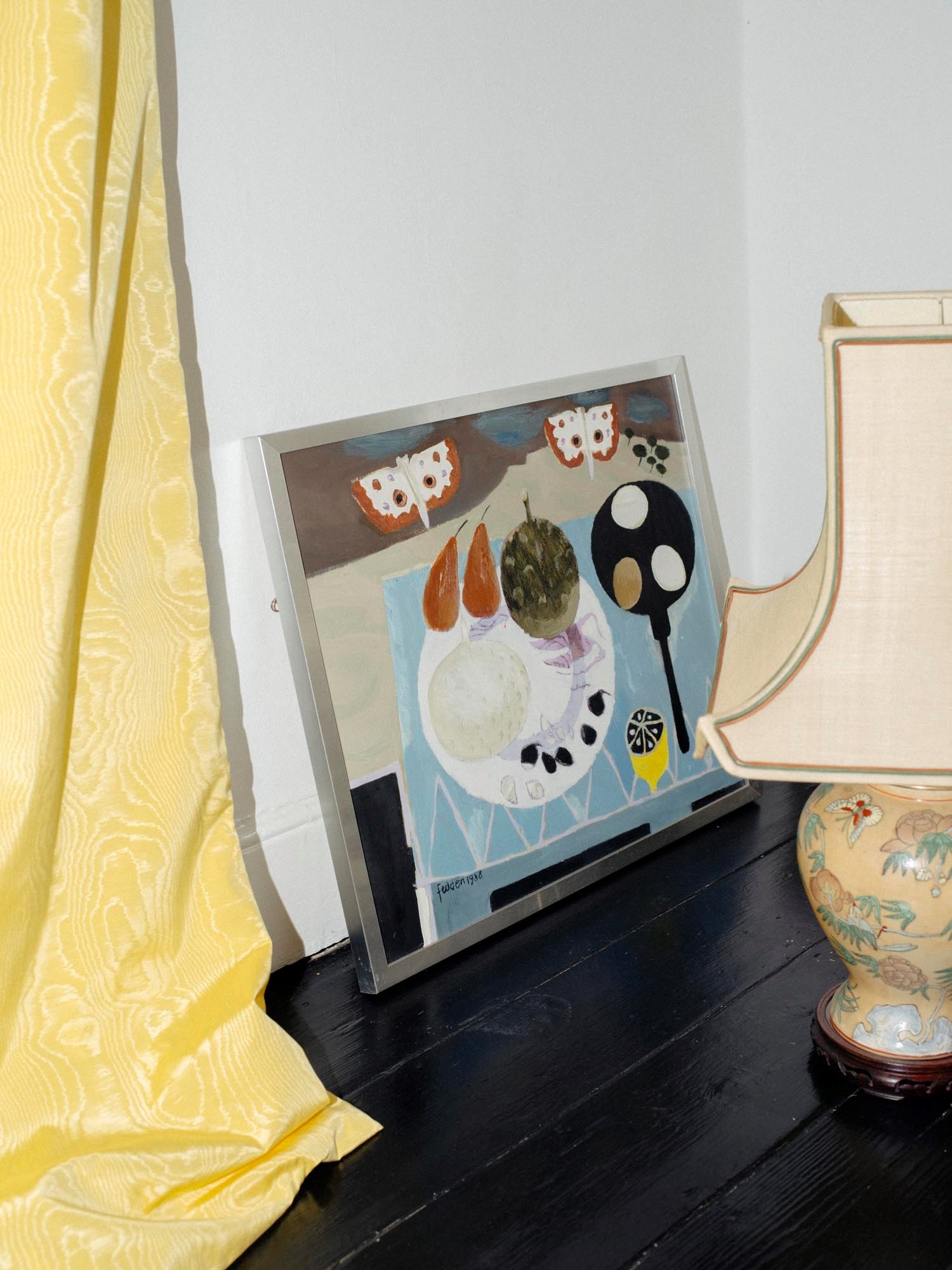
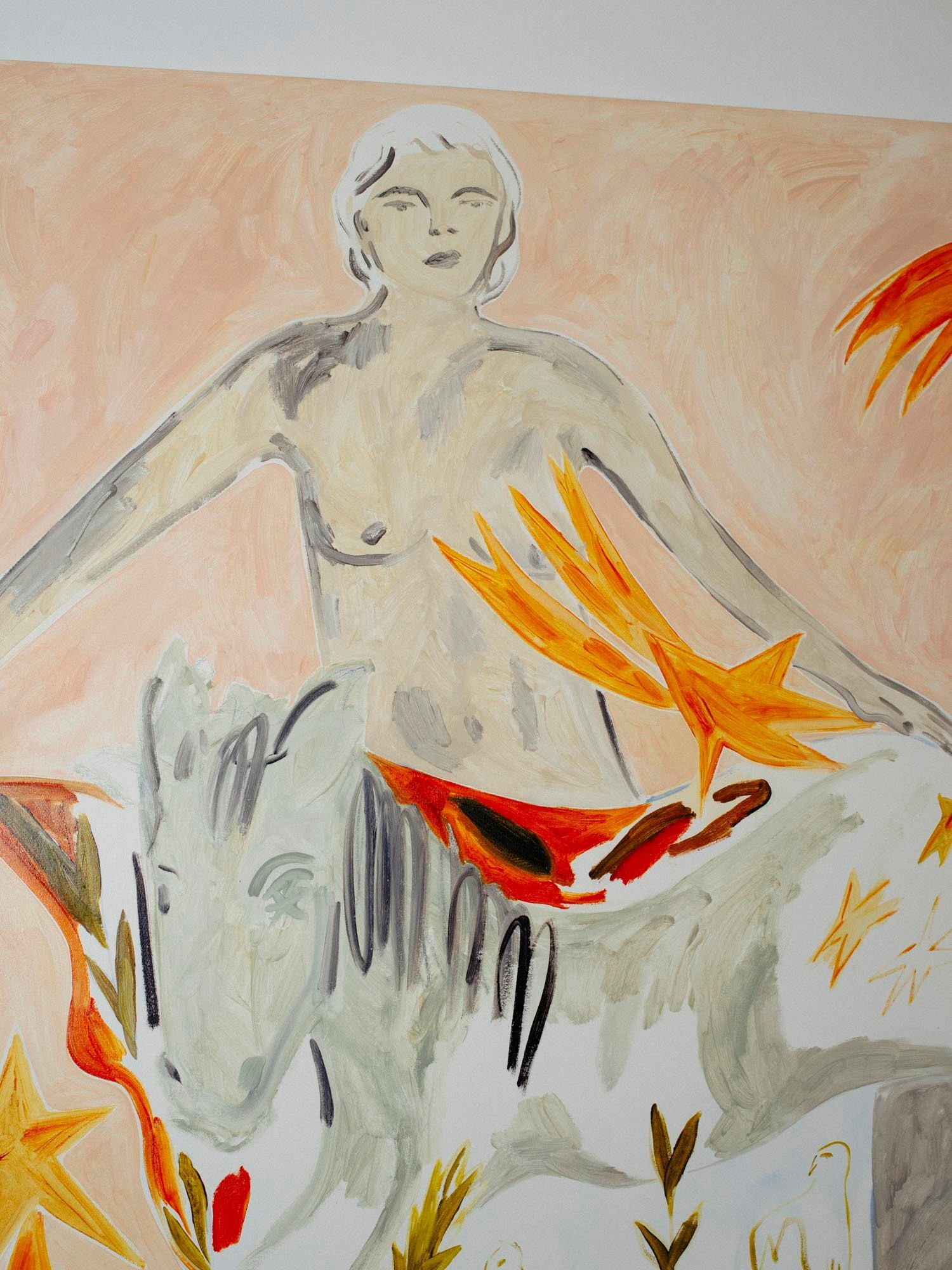
Left: Mary Fedden
“This picture is an artist called Mary Fedden, a really quite well known artist from the 80s. I was lucky enough to inherit that for my 18th birthday, my parents bought it when I was a baby for a bargain.”
Right: Faye Wei Wei
“The Faye Wei Wei! That piece, I’m so lucky to have it. I was working with her for a while, and she did a residency in upstate New York with her friend. I can’t remember how many paintings she made, but there were two just sitting in her friend’s studio, and no one could bring them back to London because it’s so expensive to ship paintings of that size. I was half living in New York at that point, so I went to see them. I bought one, and sold the other one to a friend of mine. It’s one of her biggest works, I think – my friend and I put the paintings in the back of his van and drove across Brooklyn with them, and we had real problems getting up the stairs. My apartment in New York was too small to hang it, so it leant against the wall and it towered over the couch until I moved back to the UK. To me, that’s collecting; not waking up one day and deciding you want to buy art but finding it along the way, along the journey.”

Right: (Clockwise from left) Jono White, Leo Fitzpatrick, George Rouy, Bruce LaBruce, Anna Koak, Alba Hodsoll, Bruce LaBruce
“This is a collection of sexy work that I’ve hung in the spare room to get my guests in the mood, and so far it’s done wonderfully. There’s lots of notches on this bed frame. They’re just random bits I’ve collected over the years.
“The one with the woman in the bath, that’s a drawing from a zine collection by an artist called Leo Fitzpatrick. This nude on the bed is a photographer called Jono White, a friend of mine. I put that in a show years ago and he never asked for it back, so here it is. That bull is a painting by George Rouy, who also has something else in the other room. That’s a drawing by an artist called Alba Hodsoll who I’ve known for years, I did her first ever studio visit with her, so it’s really special. This is a photograph of a glory hole by Bruce LaBruce, who was also massive in the New York scene in the 80s. This is a picture of Kembra Pfahler that he took, she’s an amazing artist represented by a gallery called Emalin. She does performances and she’s just quite incredible, I don’t have any of her work, but I’ve got a picture of her, so that’s nice. Then that drawing at the bottom is by an artist called Anna Koak. She’s based in San Francisco, and I actually found her online, a friend of mine bought her work and showed it to me. She does these incredible big paintings, and that’s a smaller work that I bought from an art fair.”
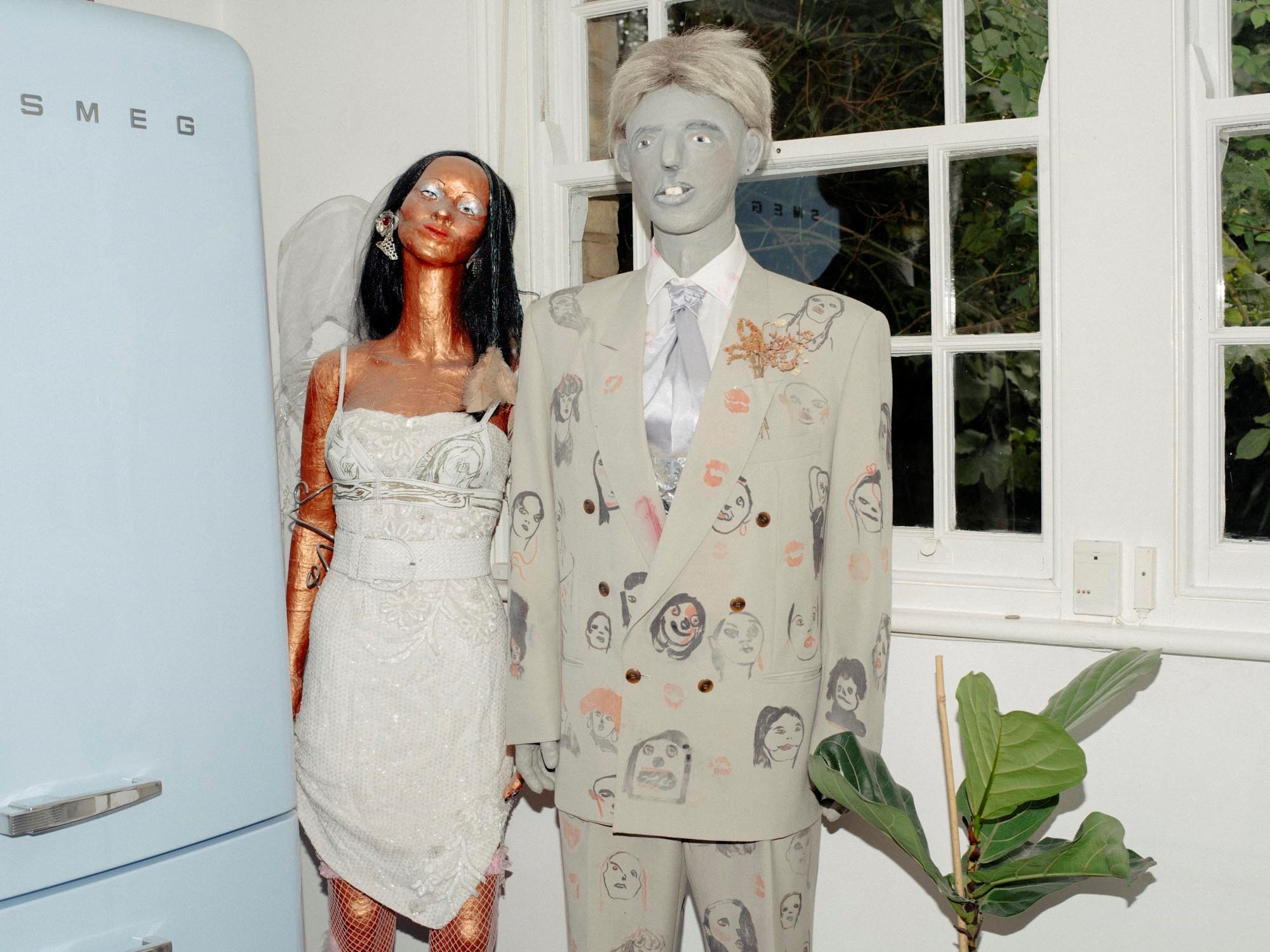
Claire Barrow
“These two are by Claire Barrow. She adapted actual mannequins for a show a while ago, and I was obsessed with them for so long. They’re such a good time, they don’t freak me out at all. They’re in my kitchen because there’s nowhere else for them to hang out – everyone has a go at me for putting them in the pink room, even though they look really good in there, in case kids walking past get freaked out. She was at the end of my bed in the other flat for ages. You just get used to having them around.”
Claire Barrow, Pig Latin Library runs until November 18, 2018 at Soft Opening, Piccadilly Circus station, London.
